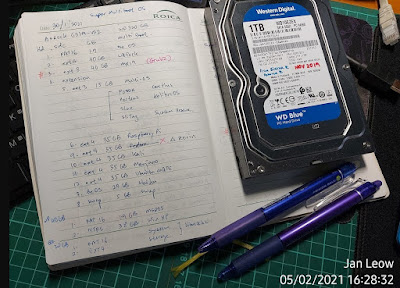And my final addition to the GRUB2 menuentry is the System Rescue CD ISO. Normally this is best installed in a USB stick or in a CD-ROM for use in an emergency. For the fun of it, I decided to try running a live version off from a PC.
Tiny Core Plus Linux GRUB2 menuentry
For a super-duper lightweight Linux distro, I think this one takes the cake! Tiny Core Linux has 3 different cores to choose from: Core (16MB), Tiny Core (21MB), Core Plus (163MB). After testing them out, I decided to go for the 163MB installation image.
SLAX GRUB2 menuentry
SLAX is a super small lightweight Linux distro. It used to be based on Slackware, hence the name SLAX. However, nowadays, it is based on Debian. It has a very nice GUI and some basic software. Since it is based on Debian, you can easily install more software to make it useful.
SliTaz Rolling Core GRUB2 menu entry
SliTaz Linux is really small! As a super lightweight Linux distro, the compressed ISO form takes up about 50MB. It was mentioned in the SliTaz website that the decompressed root file system will take up 100MB. A quick check with my install, the storage used up so far was about 60MB.
Porteus GRUB2 menu entry
Porteus is a super lightweight Linux operating system taking up about 300MB of storage space. It uses a squashed format for storing its core files, and will decompress when you boot. It also uses a modular approach whereby you install pre-compiled packages as opposed to the standard Linux using package manager.
Because it is also portable, it is easy to install into any existing Linux installation. In my case I copied the ISO files and placed it in the same partition as my FossaPup, KolibriOS, SLAX, SliTaz, TinyCore and SystemRescue.
Kolibri OS GRUB2 menu entry
Kolibri OS is another alternative operating system that is non-Windows, non-Linux. It is a super lightweight OS that was branched off from Menuet OS from 2004. It uses very little storage space and very light on hardware resources. I got intrigued with it when I happened to bump into a YouTube video showing how super fast it booted up!
Until now I still haven’t got a chance to try out Menuet OS because it needed to rawwrite onto a 1.44” floppy disk. I haven’t gotten around to collecting the stuff to try it out and then this KolibriOS came along. Ok, since they should be similar I will try this first. Besides this operating system felt simpler to prepare. The image was an ISO file and it was just a matter of burning it to a CDRW to give it a go.
Haiku OS GRUB2 menu entry
Haiku is the current continuation of the old discontinued BeOS system. I had the BeOS installation CD a long time ago and played with it a little when it came out. It didn’t catch on and sort of fizzled out. But lived on as an open-sourced Haiku.
I was surprised to find Haiku as a form of BeOS still hanging around the internet. I have been curious about the various OS that have been developed and how the usability of the different OS compared against the big giant Microsoft and the interesting Linux OS.
LibreElec GRUB2 menu entry for booting
I first learned about LibreElec when I got my Raspberry Pi 4. Having played around with it to watch some movies and connect to Netflix, YouTube and Spotify in the little RPi SBC, I was thinking of installing it on my spare old PC.
LibreElec has a simple Linux shell making it very lightweight. It just concentrates on being a media player by running Kodi fully.
FossaPup Puppy Linux GRUB2 menu entry
Puppy Linux is one of the most handy of the super light linux and considered my goto distro whenever I need to make changes, edit files, and copying files or moving files between distros and between partitions. It dispenses with the need to key in sudo privileges because it is already considered as root and has no issue whatsoever when I need to access another Linux partition.
GRUB2 Menu Entry Manually Set Up For Non-Detected Linux & Other OS
My earlier post about super multi-boot using Linux GRUB2 as my main boot loader and menu selection had been fun to do! There were also some tricky issues such as some OS need to be installed first before Linux and other OS could be installed.
Now we come to the issue of those Linux OS that could not automatically be detected by way of issuing terminal command ‘update-grub’ and had to be manually written into the GRUB configuration. I scoured the web for the commands and there were some variations to the menu entry. In some cases, some amount of tweaking was required in order to get it to work.
How Much Hard Disk Space to Allocate for each Linux and Windows Multiboot OS
During my preparation for a super multiboot computer, I needed to know how much hard disk space to allocate for the various Linux, DOS/Windows and alternate operating systems. These were usually easy to check by visiting each of the distros websites. Anyway, I took some gparted partition manager screenshot of my hard disk, hopefully this would give a fair idea of how much space each distro used up.
How To Build a Super Multi-Boot Linux OS
Having cleaned up several of my old PCs, I’ve decided to embark on my next project. To make a super multi-boot OS system with Linux, DOS, Windows XP and alternate operating systems. Dual-booting is fairly easy, but multi-booting with 10 OSes, now that would be a feat! In order to cram in so many OS, some prior preparation would be needed. Since these are old PCs with Pentium 4, Dual-Core and Core 2 Duo, I would need to look for pretty lightweight Linux. I also wanted some alternative non-linux, non-Windows OS.

